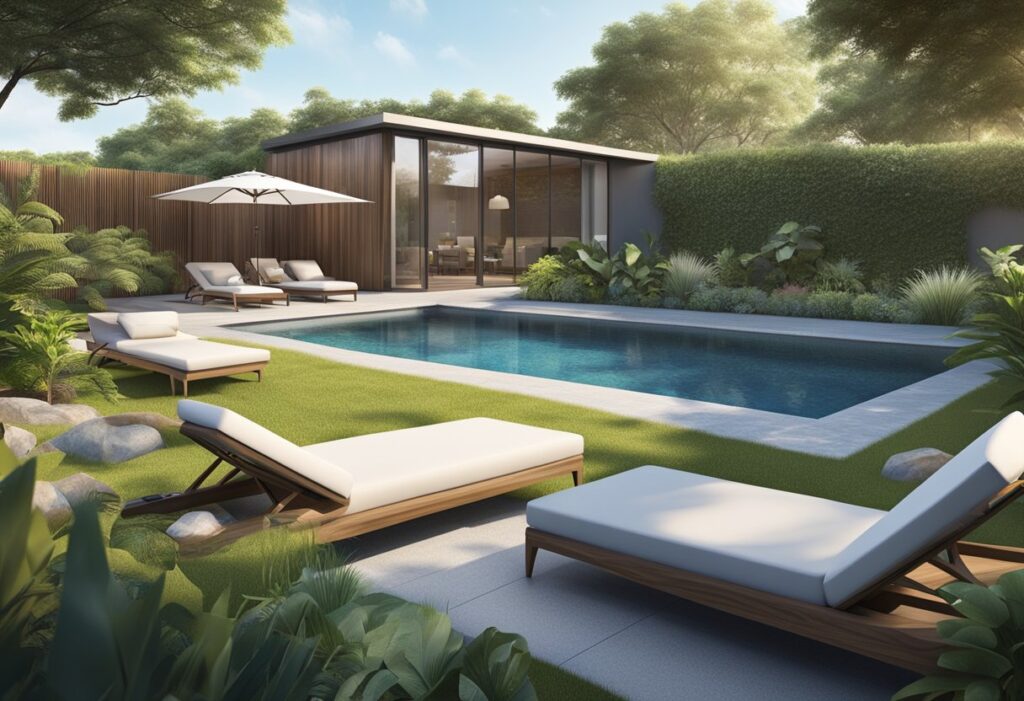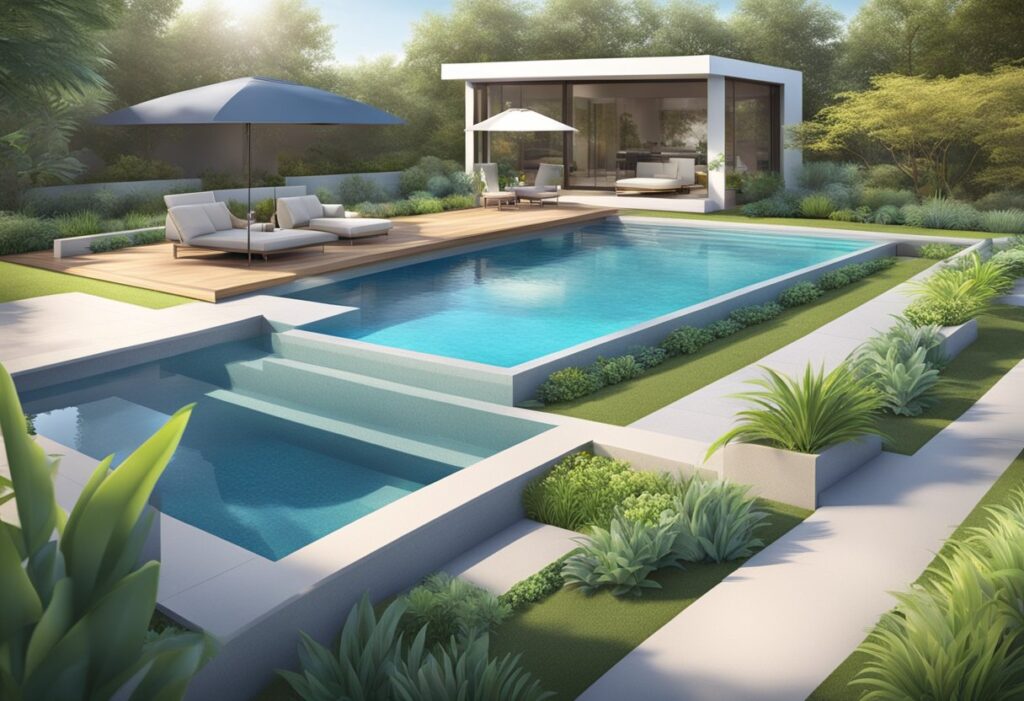When considering a switch to a salt water pool system, it’s essential to understand how it might enhance your swimming experience. Salt water pools employ salt chlorine generators to convert salt into chlorine through a process called electrolysis. This provides a steady supply of chlorine, which is necessary for keeping your pool water clean and free of harmful bacteria and algae. Unlike traditional chlorine pools, a salt water system tends to offer a more gentle and comfortable swimming environment with water that feels softer on your skin.

With a range of salt chlorine generators available in the market, making the right choice for your pool can be somewhat overwhelming. The best salt water pool systems are designed to be user-friendly and efficient. They should offer reliable chlorination performance, be constructed with high-quality materials to withstand various weather conditions, and come with a solid warranty for peace of mind. These systems not only regulate the chlorine levels in your pool but may also include features such as built-in pH control, which ensures the water remains at a healthy level for swimming.
It’s worth noting that the ideal salt chlorine generator for your pool will depend on several factors including the size of your pool and the climate you live in. Tropical climates, for example, may require a system that’s specifically designed to handle higher water temperatures, while smaller, above ground pools have different demands than larger, in-ground pools. In selecting a salt water chlorinator, consider your pool’s volume and seek out a system that can manage your specific requirements effectively.
Understanding Salt Water Pool Systems
When considering a salt water pool system, you’re looking at a setup that will utilise salt chlorination for sanitising your pool, which often results in softer water and reduced chemical handling.
Salt Water Chlorination Process
Your salt water pool system operates through electrolysis, where sodium chloride (ordinary salt) is converted into chlorine. During this process, salt is added to the pool water to achieve a desired salinity level, typically between 2,700 to 3,400 ppm (parts per million). This saline water then passes through the salt chlorine generator, where an electrical current causes the electrolysis that produces hypochlorous acid, the sanitising agent.
Components of Salt Water Systems
The core components of a salt water pool system include the salt chlorine generator, control box, and generator cell. The generator cell is where salt is converted into chlorine, and the control box manages the system’s operation. Additionally, flow switches and sensors are vital, as they monitor water flow and salinity to ensure the process is efficient and safe for swimmers.
Benefits of Salt Water Pools
Salt water pools boast several benefits:
- Soft water: The softer feel is gentler on your skin and eyes.
- Health: Lower chlorine levels reduce the prevalence of chloramines, compounds that can cause skin irritation and discomfort for swimmers.
- Maintenance: These systems tend to require less frequent attention than chlorine pools, simplifying your pool care routine.
Comparing Salt and Chlorine Pools
Comparing salt water pools to traditional chlorine ones:
- Chemicals: Salt water pools generate their own chlorine, reducing the need to store and handle chemicals.
- Water quality: Many users report better water quality — clear and gentler on the skin.
- Equipment: Salt water systems might involve higher upfront investment, mainly due to the cost of the salt chlorine generator and other related equipment.
- Maintenance: Salt water systems still require monitoring and maintaining to ensure they function properly, although they can reduce the time and effort spent balancing chemicals.
Choosing the Right Salt Water Pool System
When selecting a salt water pool system, considering factors such as cost, pool size, ease of use, and maintenance requirements is crucial to making an informed decision. Specific systems cater to different pool types, offering varying features and warranty terms.
Factors to Consider
- Cost: Assess both upfront costs and running costs of salt water pool systems.
- Ease of Use: Look for systems that offer user-friendly operation.
- Effectiveness: Ensure the system effectively maintains water clarity and hygiene.
- Pool Size: Choose a system adequate for your pool’s volume, whether it’s above-ground or inground.
Salt Water System for Different Pool Types
- Above Ground Pools: Certain systems are specifically designed for above-ground pools, requiring adapters for compatibility.
- Inground Pools: Other systems may offer more robust features suitable for inground pools.
Top Salt Water Pool Systems and Features
- Pentair Intellichlor IC40: Known for its efficiency in pools up to 151,414 litres.
- Blue Works: Offers a range of systems with varying capacities.
- CircuPool: Delivers systems that are popular for their longevity and warranty coverage.
Maintenance and Care
- pH Levels: Keep the pH levels between 7.00 and 7.80 for optimal chlorination and comfort.
- Total Alkalinity & Water Hardness: Regularly test and adjust to maintain the right balance.
- Cyanuric Acid: Use stabilisers as necessary to protect chlorine levels.
Warranty and Support
- Warranty Coverage: Check the duration and terms of the warranty. Replacement salt cells should be covered.
- Customer Service: Ensure that customer support is readily available for troubleshooting and guidance.
Operational Tips and Best Practices
Maintaining a salt water pool system requires diligence, but by following these tips and best practices, you can ensure efficient performance and pristine water quality.
Regular Maintenance and Monitoring
Chemicals: It’s essential to regularly test and adjust your pool’s chemical levels. Aim to maintain a salt concentration of 2,700 to 3,400 PPM (parts per million) for optimal sanitiser effectiveness. Keep free chlorine levels between 1-3 PPM to effectively kill bacteria and algae.
- pH Levels: Regularly check pH levels and use pH reducing products if it rises above 7.6. A balanced pH is crucial for the chlorine to work effectively.
- Salinity: To maintain appropriate salinity levels, only add pool salt as needed, typically after heavy rainfall or significant water replacement.
Troubleshooting Common Issues
Solving Algae and Bacteria Problems: If you notice algae or bacteria, elevate the chlorine level temporarily to super chlorinate the pool water. For some systems, this may be done using a ‘self-cleaning’ or ‘boost’ mode.
- Calcium and Scale Build-Up: To prevent scale, clean the cell according to the manufacturer’s guidelines, monitor calcium hardness, and consider using a scale inhibitor as part of your routine maintenance.
Enhancing Pool Performance
Optimising Sanitisation: Ensure that your salt chlorinator is functioning properly to convert the adequate amount of salt into chlorine. This process, known as electrolysis, is key to sanitising your pool efficiently.
- Upgrading Components: Keep an eye on the condition of your system’s components. Replace them as necessary to maintain high performance. Also, consider the option of features like automatic self-cleaning modes to minimise manual maintenance.
Additional Considerations

Choosing the best salt water pool system requires attention to detail in areas that can impact your health, the environment, and your wallet. Here, you’ll find a distilled list of key points to guide you through what may sway your decision.
Health and Safety
Your health and safety should be at the forefront when selecting a pool system. A well-designed saltwater chlorinator should maintain optimal salinity levels at about 3,000 to 4,000 parts per million (ppm), mimicking the natural salinity of human tears. This level of salinity is essential for comfort and helps minimise eye and skin irritation. Ensure the system you choose is capable of consistently monitoring and adjusting chlorine levels to maintain safe swimming conditions.
Environmental Impact
When pondering the environmental impact of your pool system, consider saltwater chlorinators that have a strong design focus on energy efficiency. High-efficiency models consume less power, reducing your carbon footprint. Additionally, saltwater systems, in general, are known for requiring fewer chemicals than traditional chlorine pools, which lead to less chemical runoff into the environment.
Purchasing Advice
In seeking the best budget saltwater pool system, look for products that provide the best value without compromising quality. It is not unusual to find affiliate links in the comment section of pool system reviews, which can be a useful direction to discounts, but ensure that you validate the authenticity of these offerings. Moreover, a pool cover is an advisable purchase to accompany your system to keep the water from debris and help in retaining the heat. For those with a spa, it’s essential to confirm compatibility, as saltwater systems can vary in their ability to service different water volumes effectively.











